Look no further this is the only fresh homemade pasta dough recipe you need. It works every time. With just flour and eggs and this super detailed guide you will produce pasta like a professional. Perfect silky pasta sheets every time. I have all the tips and tricks for pasta dough that will have you returning time and time again to the kitchen.

Hello! I am writing up this comprehensive guide to my easy homemade pasta dough with every tip and trick I can think of. This guide will set you up perfectly to have success EVERY time you make pasta. If this is your first time making pasta you could check out my guide where to start for making homemade pasta.
In this guide I will take you through the process of bringing the pasta dough together as well as the rolling guide. I use a marcato roller but I also have the kitchen aid pasta attachment. Both work really well!
From here you'll have the perfect base to make any pasta shape you like, homemade pappardelle is a favorite but you could use the cutter attachments you might have got with your machine to make fettuccine or spaghetti too. Check out my guide to homemade ravioli too!
Jump to:
- Main ingredients and special equipment
- What is semolina?
- How to make pasta dough
- Why the double rest?
- The difference between Semolina and Semola
- How to roll pasta dough
- What can I make with it?
- How long do you boil fresh pasta?
- Can you make pasta dough without eggs?
- Gluten free pasta dough
- Other Recipe FAQs
- Some pasta dishes to try
- Recipe
- Comments
Main ingredients and special equipment
- Scales - There is absolutely no way you can make pasta without scales. I weigh the flour AND the eggs which ensures a perfect pasta dough every time. No guess work.
- Flour - I use a combination of two types of flour, '00' flour and semola rimacinata, which is a very finely milled semolina flour. You can just use all '00' though and all purpose flour works fine too.
- Room Temperature Eggs - I learnt early on in my pasta making journey when reading Evan Funke's cookbook that weighing your eggs is the best method. Eggs vary in size so much so by weighing them you reduce any risk of a dough that is either too wet or too dry. I put a bowl on my scales then crack the eggs in until I get the weight I need.
- Pasta Machine - You can roll out a sheet of pasta with a rolling pin but it is very hard. I use a marcato roller and I also have the kitchen aid pasta roller attachment.
My biggest tip!
Purists will hate me but my biggest tip is to bring the dough together in a food processor! It is cleaner, quicker and easier. Put the flour and eggs straight in and pulse until it resembles breadcrumbs (an even mixture). Take the blade out and use your hand to squeeze the mixture into a ball then bring it out onto the bench to knead.
Other things you will need
- Wooden cutting board
- Plastic wrap - fresh pasta dough needs to be tightly wrapped at all times.
- A sharp knife - To cut the dough ball and edges of sheets. You could also use a pizza cutter or a fluted pasta wheel for edges on shapes like ravioli.

What is semolina?
I like to add semola (a fine semolina flour) to my dough but it's totally optional. It is a flour milled from a kind of wheat called durum wheat. It is just a different type of wheat and is often classed as a 'hard wheat'. The '00' flours or even plain flour is more of a 'soft wheat'.
Basically what that means is that shapes made out of a semolina pasta dough will have more of a bite, they often have, in my opinion, a really addictive and delicious chewy factor. When you add semolina into an egg pasta dough like this one, it helps to add structure and an al dente bite. You can leave it out altogether though.
How to make pasta dough
Full method and ingredient measurements (plus a video) are in the recipe card below! As I mention above you could skip this first section and bring the ingredients together in a food processor! It's SO much quicker and cleaner!
I am showing the traditional way on the bench top but it's also much cleaner in a big mixing bowl. The end result of a bench, bowl or food processor will be EXACTLY the same so do what suits you.
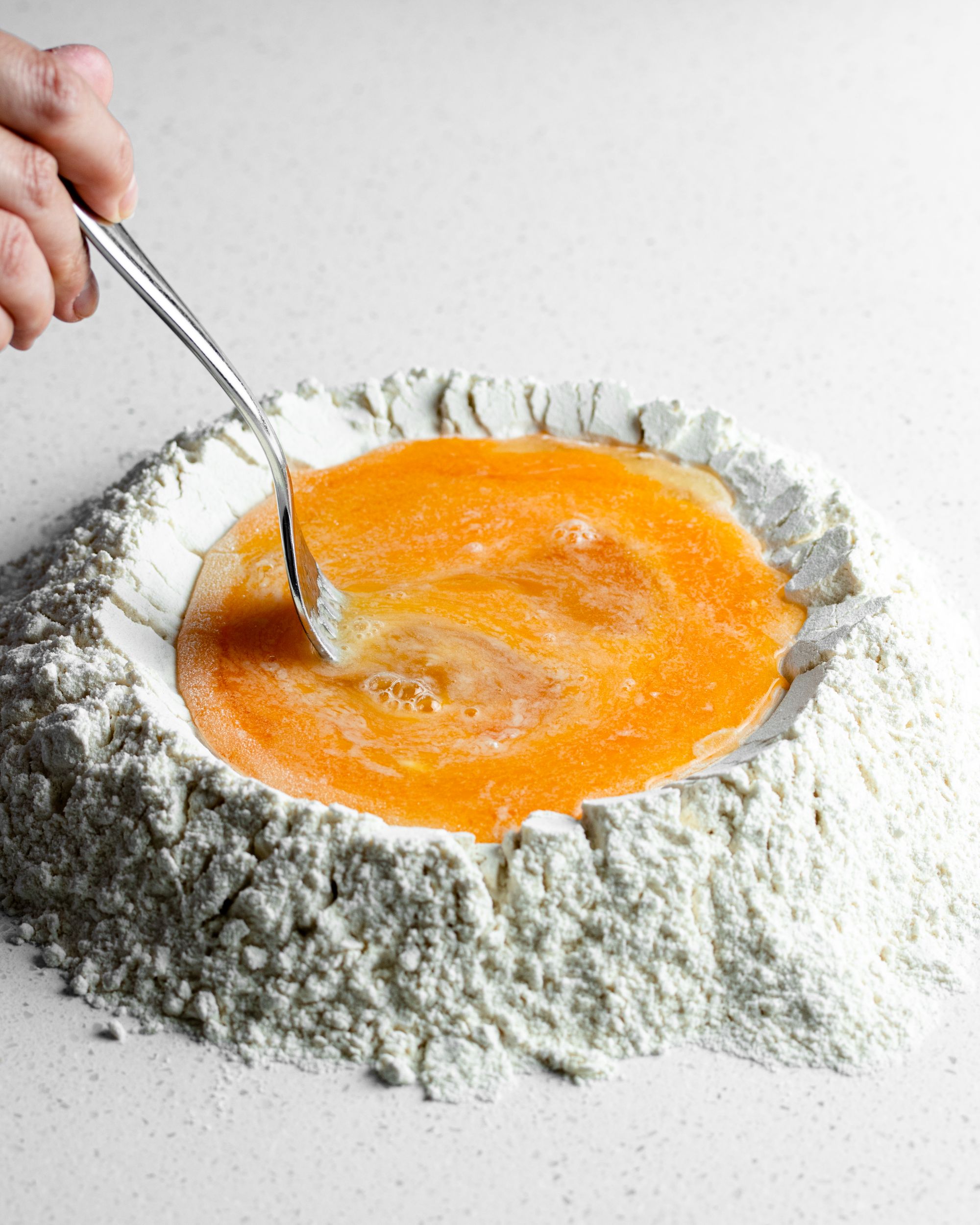
- Tip your flour into a mound on the bench and make a well to tip your mixed eggs into.
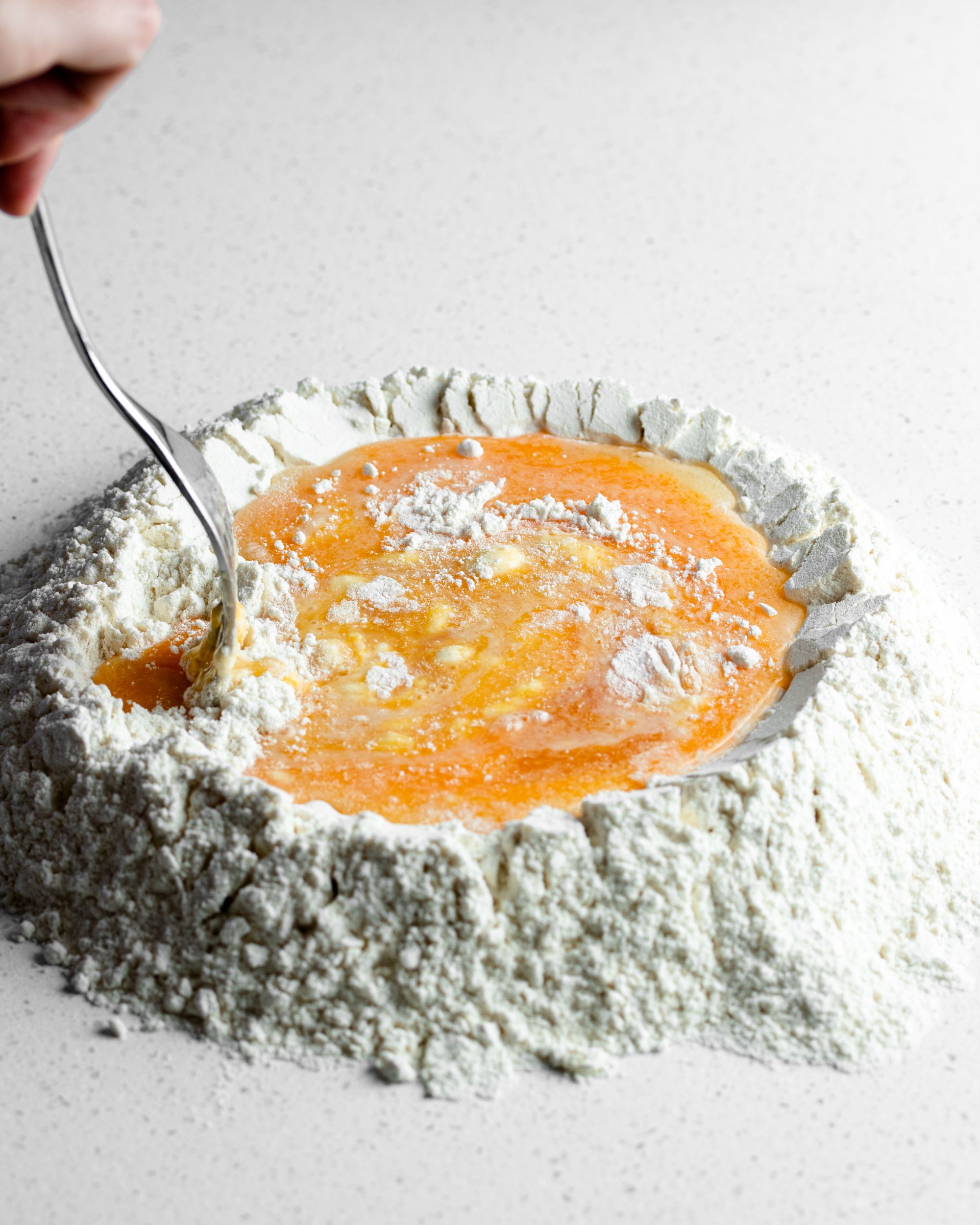
2. Start to bring the flour from around the edges into the middle, mixing with your fork.
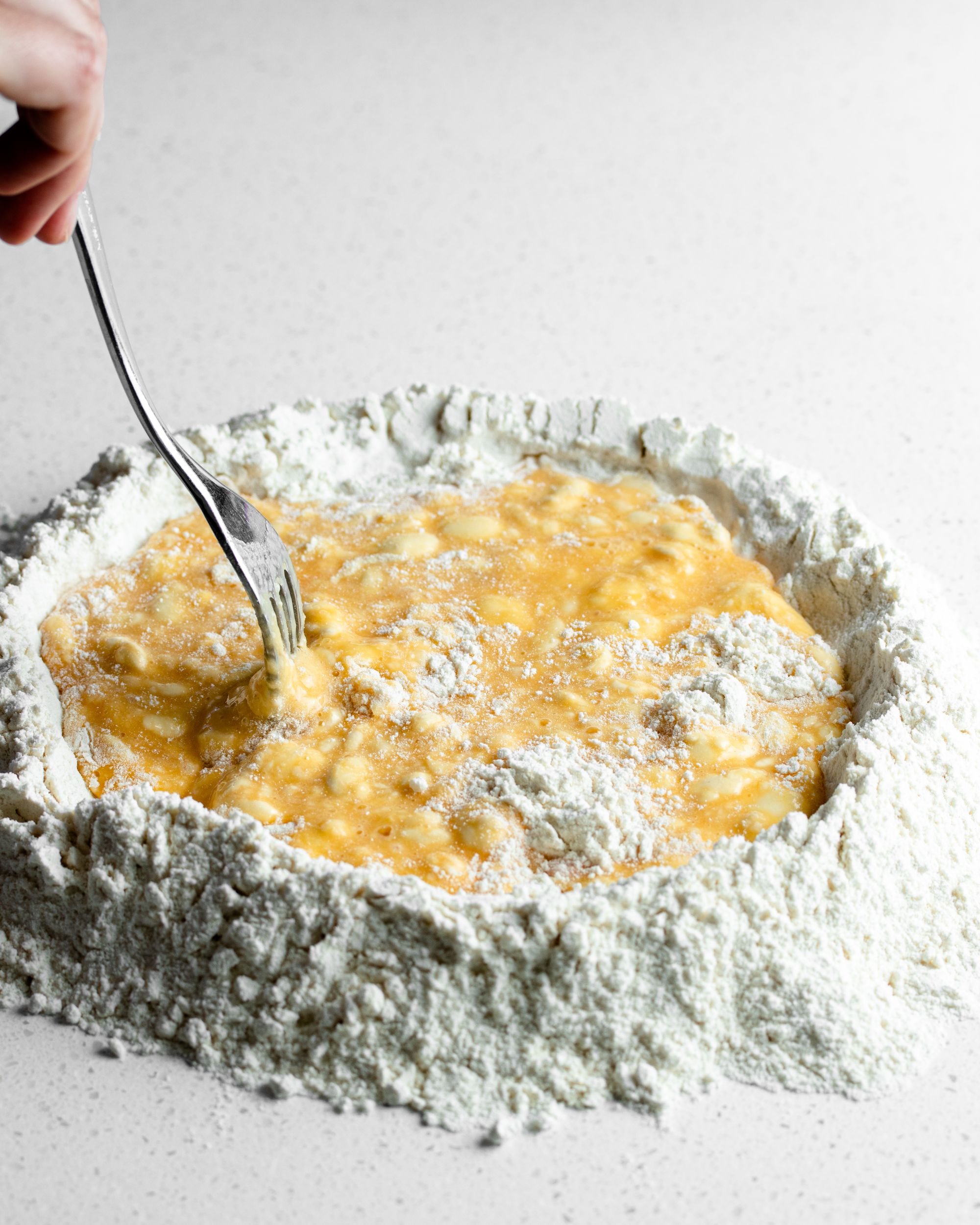
3. Keep mixing, incorporating the flour until the middle is thick and a scrambled egg consistency.

4. With a bench scraper or hands, fork, spoon start to fold all the flour into the middle.

5. It doesn't matter how you do this and it will be a mess but it comes together I promise!

6. With the scraper or fork use a cutting motion up and down to try and get everything really evenly incorporated.

7. However you get there we just want a shaggy even mixture like this.

8. Bring the mixture together with your hands, squeezing it into a rough ball.
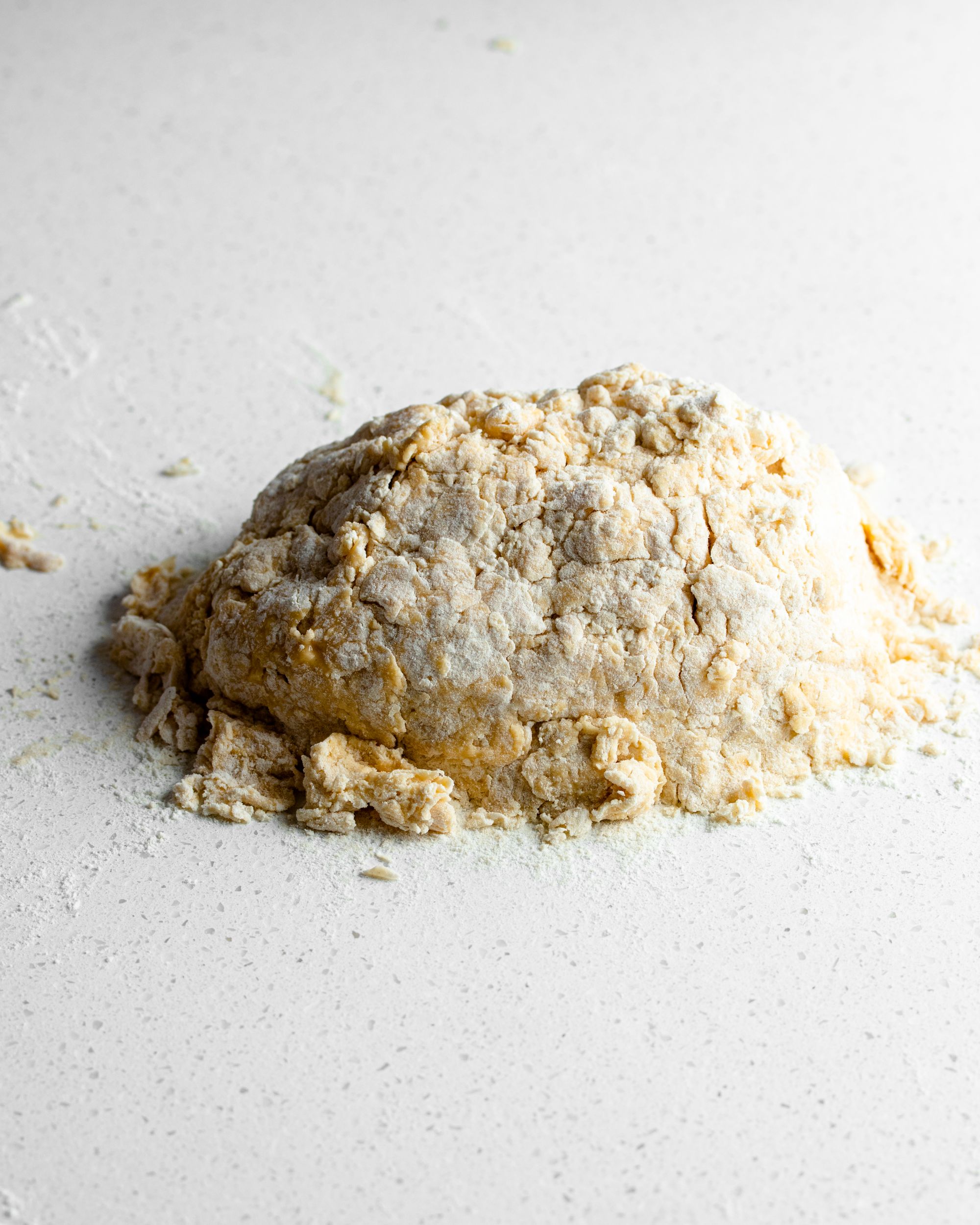
9. Squeeze and squeeze until it forms a ball. Again, it will come together, don't stress!

10. Knead for 3 - 4 minutes quite vigorously.

11. When it looks dimpled like this wrap it up tightly in plastic wrap and rest for 10 minutes.

12. After 10 mins you'll knead again (see below).
After the first rest

- Continue kneading for 3 minutes or so until you have a nice smooth dough.

2. Wrap up tightly again and rest for 30 minutes or up to an hour.
Why the double rest?
It really is a game changer and does a lot of the work for you just by sitting untouched! When you are bringing a pasta dough together you are hydrating the flour with the eggs. It needs time to do this so by resting it for that first 10 minutes you are giving it a chance to do so. You'll be quite surprised how different the dough feels after that first rest. It means you won't have to knead it for as long as you would normally.
The difference between Semolina and Semola
This is something that confuses a lot of people and is VERY important! Both are made from exactly the same wheat but are milled differently. Semola is what we call really fine semolina it is also the flour that goes into this egg dough along with '00'. It will most often be labelled semola rimacinata.
Would you like to save this?
What is labelled semolina is a much coarser flour but is also used in pasta making, just not in the dough. When making any kind of pasta having the coarser semolina on hand is very handy for dusting trays and preventing the pasta from sticking.

How to roll pasta dough
This will be the only rolling guide you'll ever need. I take a few extra steps to ensure I get the silkiest smoothest pasta sheets possible. To start with, only work with a quarter of your dough at a time, even a sixth if you haven't rolled out dough before.
It's all fun and dramatic when you see people rolling out metre long sheets but it's difficult, impractical and unnecessary in my opinion! Keep the rest of the dough you aren't using tightly wrapped up.

- Press the quarter piece down flat with your hand or a rolling pin and dust with a little flour.

2. Roll it through the widest setting.

3. You'll have a long oval, so take the rounded ends and fold them into the middle to create a rectangle.

4. Roll it back through the roller at the widest setting and then the next setting (that is 1 and 2 on a marcato or kitchen aid)
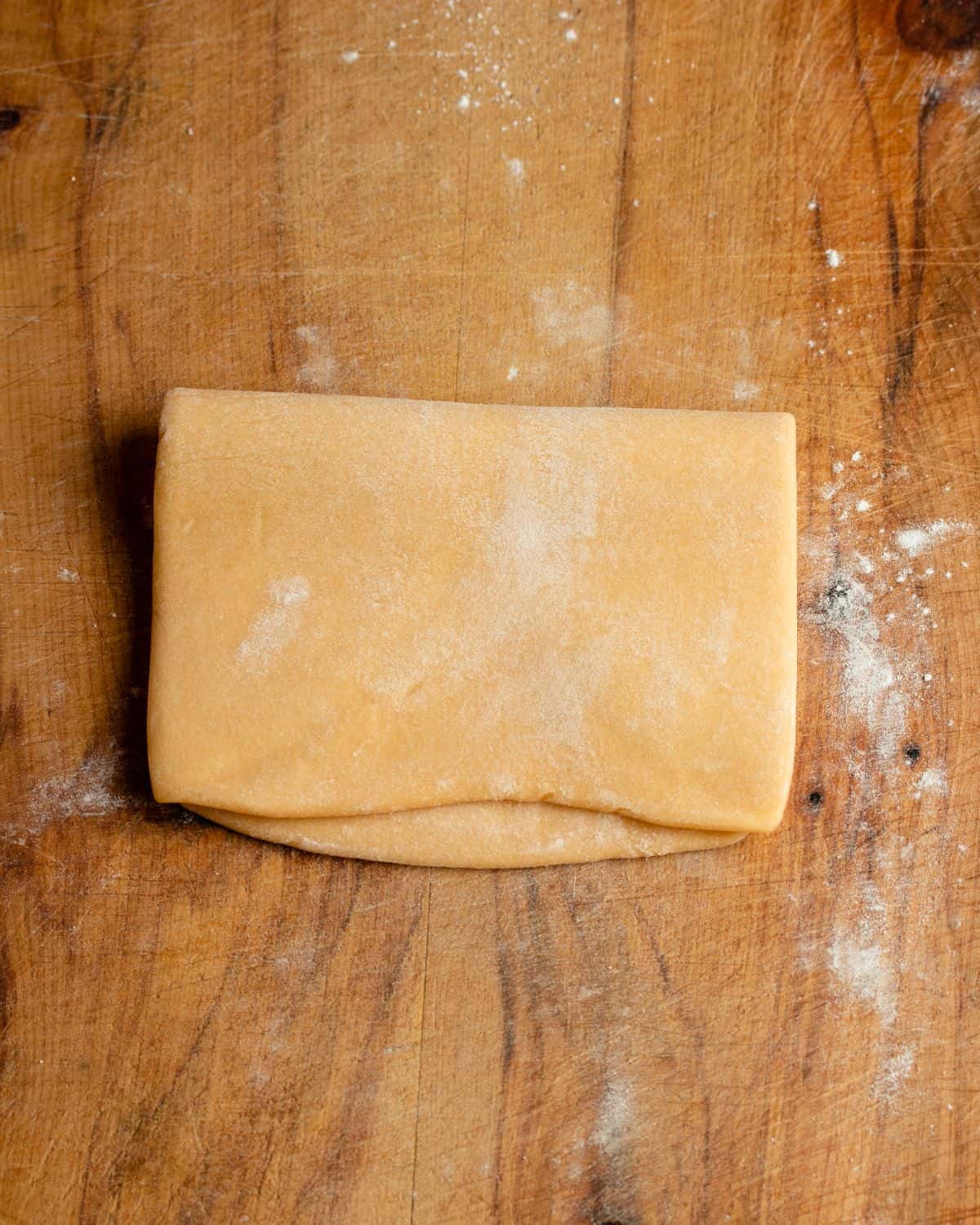
5. Fold the rectangle in half and dust with a little flour.

6. Take it back through the widest setting.

7. Now roll it through each setting 1, 2, 3 and 4.

8. After setting 4 fold the sheet into three.

9. You might need to trim the edges if it gets too wide for the roller.

10. Now take it back to setting 2 and go through them all again stopping at 6 or whatever thickness you like.

11. This is what gets extra smooth perfect sheets, folding and re-rolling is the key!
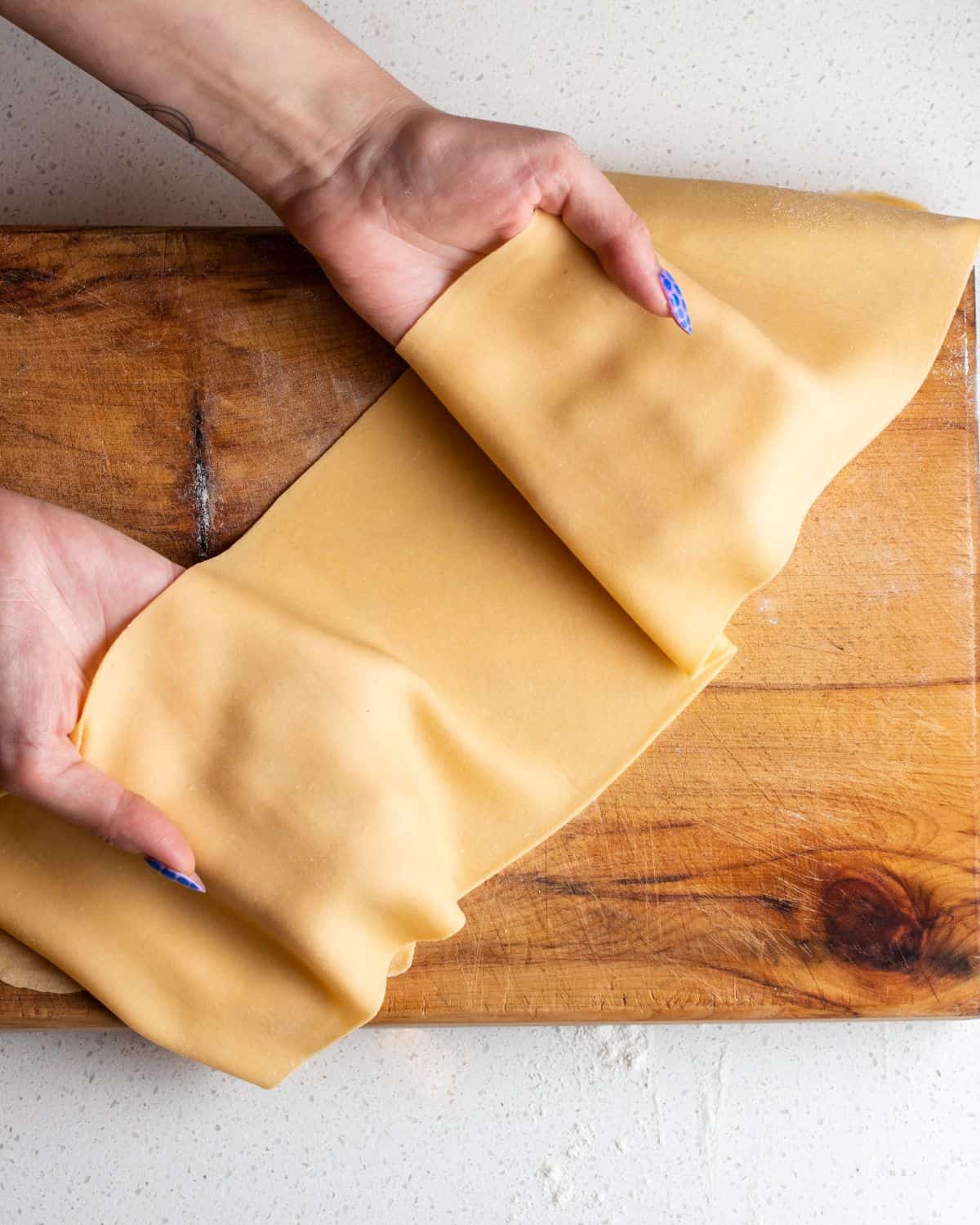
12. You'll now have a perfect sheet to use however you wish!
You should end up with a silky smooth pasta sheet! The thing to remember is as far as I am concerned there is no right or wrong way to do this! Experiment and find your own way. As long as you are going from the widest to the thinnest, who cares how you get there. ENJOY the process!

What can I make with it?
So many things! If you are a beginner pasta maker I would suggest cutting the pasta sheets into homemade pappardelle. Most machines comes with a pasta cutter you can attach which cuts the pasta sheets into spaghetti or tagliatelle. Remember, fresh pasta cooks quickly and these shapes will only take 2 minutes or so to cook.
Once you are feeling confident then homemade ravioli will be your next project, it might seem like hard work but with my guide it is very achievable. Another easy filled shape to make is my triangoli with a simple ricotta filling.

How long do you boil fresh pasta?
It depends on the shape you make. For a thin pappardelle, fettuccine or spaghetti then it should only need 2 minutes. Check it at 2 mins and see what you think. For filled pasta shapes boil for 4 - 5 minutes. Again it depends on the thickness so you might need to experiment.
Can you make pasta dough without eggs?
Absolutely! There are two different types of pasta doughs in Italian cooking. Firstly, this classic egg and flour dough and secondly a flour and water dough. Most flour and water doughs are made with semola rimacinata, which is widely available. This is used for hand rolled shapes like my hand rolled gnocchi sardi or homemade orecchiette.
For the most simple dough of all you could make my hand rolled pici pasta which is simply plain flour and water. If I had to choose what dough I like best it would be a struggle but I really love the process of hand rolling shapes. It's a really fun and easy way to get into pasta making and a great activity to do with friends and family.

Gluten free pasta dough
I have a really detailed guide on gluten free pasta dough. It is much easier than you might think, it's mostly in the rolling technique. If you use my recipe you should end up with a really workable dough that you can make any shape with.

Other Recipe FAQs
I use a combination of '00' and fine semolina flour. The semolina gives a bit of bite and structure. You could use all '00' or all purpose flour too.
In my opinion, no. You are much better off making a finished pasta shape and freezing that. Pasta shapes freeze beautifully and it's my go-to storing method. If making something like pappardelle freeze the finished nests open on a tray. After 20 minutes transfer to a freezer bag or airtight container.
In an ideal world the dough rest period is only 30mins - 1 hour at the most. You could stretch this to 3 if you have to. You could prepare it earlier and refrigerate but it will get more elastic and harder to work with the longer you leave it. It always needs to be room temperature when rolled.
Yes! Truth be told I do a lot! Put the flour and eggs into the food processor and pulse to combine into an even mixture. Squeeze the mixture together and then knead on a clean work surface as usual. You could also knead the dough in the bowl of a stand mixer with the dough hook attached.
Some pasta dishes to try
Did you make this recipe?
I would LOVE it if you could leave a review and star rating down below. Also please tag me on Instagram if you share a photo of the dish!

Recipe

How to Make Easy Homemade Pasta Dough
Would you like to save this?
Ingredients
- 350 g '00' flour (all purpose is fine too!)
- 50 g semola rimacinata flour (use 400g of '00' if you can't find this flour)
- 228 g eggs see notes
Instructions
- Please read all the information above plus step-by-step photos.
- Mix the flours together in a bowl then tip it out onto your bench. Create a well in the centre of the flour mound, I use the bottom of a bowl to do this so it is nice and firm.
- Tip the eggs into the well and start to whisk them with a fork, breaking up the yolks and gradually incorporating the flour from around the sides into the middle.
- Keep doing this until the mixture in the middle is thick enough that it won’t escape or run out – a scrambled egg consistency!
- Go in with a bench scraper and start to fold it all together, cutting the egg mixture into the flour in an up and down motion. You are just trying to get a really evenly incorporated shaggy mixture.
- Bring it all together into a mound with your hands. Knead the mixture for a few minutes until it comes together into a workable ball. It will – don’t fear! If it feels dry you can wet your hands and keep kneading.
- When it comes together and has a slightly dimpled surface wrap it in cling film and rest for 10 minutes. After 10 minutes knead for a further 3 - 4 minutes until you have a nice smooth dough ball. The double rest is key!
- Wrap tightly and rest for at least 30 mins but I prefer an hour.
- If you don't want to make a mess then blitz the eggs and flour in a food processor, it's how I often do it! Pulse until the eggs are really evenly distributed then take the blade out, squeeze into a ball and bring out onto the bench to knead.
Rolling
- Please check out my rolling guide in images above, it's easier to see in photos.








Kira says
Could I roll out my dough with a rolling pin if I don't have a pasta maker?
Emilie Pullar says
Hi Kira, yes definitely! Will take a bit of elbow grease but it is actually the most traditional way to do it. Work with small bits at a time 🙂
Catriona Routley says
My go to, the game changer. We had a pasta machine since we got married (10+ Years) and hardly used it. Once I found your recipe and method though we make it most weekends now- it’s perfect every time! To the point where my kids now complain if the pasta isn’t homemade….. thank you!
Emilie Pullar says
This makes me SO happy wow. So so cool, I am so glad that it's become something you love doing. Such a fun weekend activity 🙂
Kate says
This was my first time making pasta dough and it was so much fun! I planned to do this in the afternoon so I wouldn't be doing the whole thing around dinner time but alas the day got away on me. Despite that, I found the recipe very easy to follow and the tips and images are great. I made this into ravioli and it was really good! It certainly wasn't perfect but it didn't let down the meal at all. Look forward to making this again and trying new shapes!
Emilie Pullar says
Hi Kate! So glad the recipe worked out. You'll get faster each time you use it. I always use a food processor to bring it together when I am in a rush 🙂
Sally says
Will always come back for this recipe! I made with plain flour as didn't have anything fancier and it came out perfectly. I made lasagne sheets and though it seemed a faff to blanch the sheets, I did it and it really wasn't hard at all. Then with the leftover dough I rolled and cut into fettuccine for the freezer. Can wait to try some shapes or ravioli soon ??
Emilie Pullar says
Hi Sally! I actually make it with plain flour more often than not, I don't think there's much of a difference at all. So glad you come back to this one 🙂
Ben says
Still my go-to recipe for making pasta. I can never remember the exact measurements!
Emilie Pullar says
Hi Ben!! So glad! It helps me out having people on my site so I am glad you can't remember the measurements and have to come back haha 🙂
Caitlin says
My go to recipe. The best ratio/method for perfect dough, every time.
Emilie Pullar says
So happy you love the dough Caitlin!! Thank you so much for making 🙂
Lachlan says
The pasta dough is really nice and syrup stretchy. The double knead gives it such a great yellow colour. It never fails. I make really good pasta each time.
Emilie Pullar says
Hi Lachlan! So glad my dough recipe works so well. We will have to make some pasta together if you come to Auckland!
Cameron McAnarney says
First time making pasta and it was fantastic! Thank you for the easy to follow recipe!
Emilie Pullar says
Hi Cameron, yay so glad the recipe worked well for you, hope this is the start of lots more pasta!
Stuart Anderson says
I have been cooking since a young age, and honestly have always struggled with getting my pasta right. Until I came across this recipe from Emilie. I don't know if its the 50grms of Semolina that makes the difference, the secret of warm eggs, or what! But it works. I follow this step by step for all my pasta dishes at home, and for work too. Simply multiply the ingredients for a scaled up recipe. It works trust me, like I trusted Emilie and you won't go back!
Thank you Emilie!
Emilie Pullar says
Sooo happy you have had success with it Stuart!! 🙂
Michelle Murphy says
I have been making my own pasta for years…but recently I changed over to Emilie’s pasta dough recipe. Here in the US, we unfortunately don’t weigh out our ingredients as everywhere else. But when making pasta, it really does make a difference. So when I saw Emilie’s recipe called for eggs in grams, rather than how many eggs, I knew this would be a winner recipe. Not all eggs are created equal and by weighing the beaten egg, I get perfect hydration and a successful and delicious dough everytime! I’m so glad I stumbled upon you on Instagram! Always excited to see your pasta dishes 🙂 Such a talent and inspiration!
Emilie Pullar says
Hi Michelle, thanks so much for such a lovely comment, means the world! Weighing really is key isn't it! I love that it takes the guesswork out completely 🙂
Maree Tink says
Excellent! I too love the food processor. I have hand issues and it saves me pain. Tip for those mindful of zero waste, scrap the plastic wrap and use beeswax wraps. Thank you!
Jose T says
I bought a pasta machine and have tried a few variations of this recipe:
- 350g 00, 50g Sémola
- 400g 00
- 400g All Purpose
All came out well, but by far the 350/50 combination was the unanimous fave at our house.
Great recipe, great instructions. Thanks!
Emilie Pullar says
I love the 50g of semola to give it some bite! Sometimes if I am making something like a handkerchief pasta I use all '00' ad it kind of suits the softness. Thanks so much for making and commenting 🙂
Meg says
Hello! I'm new here, but looking to make ravioli for our new year's eve dinner. I don't have semola on hand and it's impossible to find it in stores where I live, do you think I can just use regular flour?
Thanks so much in advance!
Emilie Pullar says
Hi Meg! I am so so sorry for my slow reply!! You can absolutely leave the semola out and just use '00' or all purpose 🙂
Steph says
comes out perfect every time, and the mid-knead rest is brilliant!
Kathy Marvin says
I use your pasta dough recipe all the time and it’s perfect!! Thank you!!